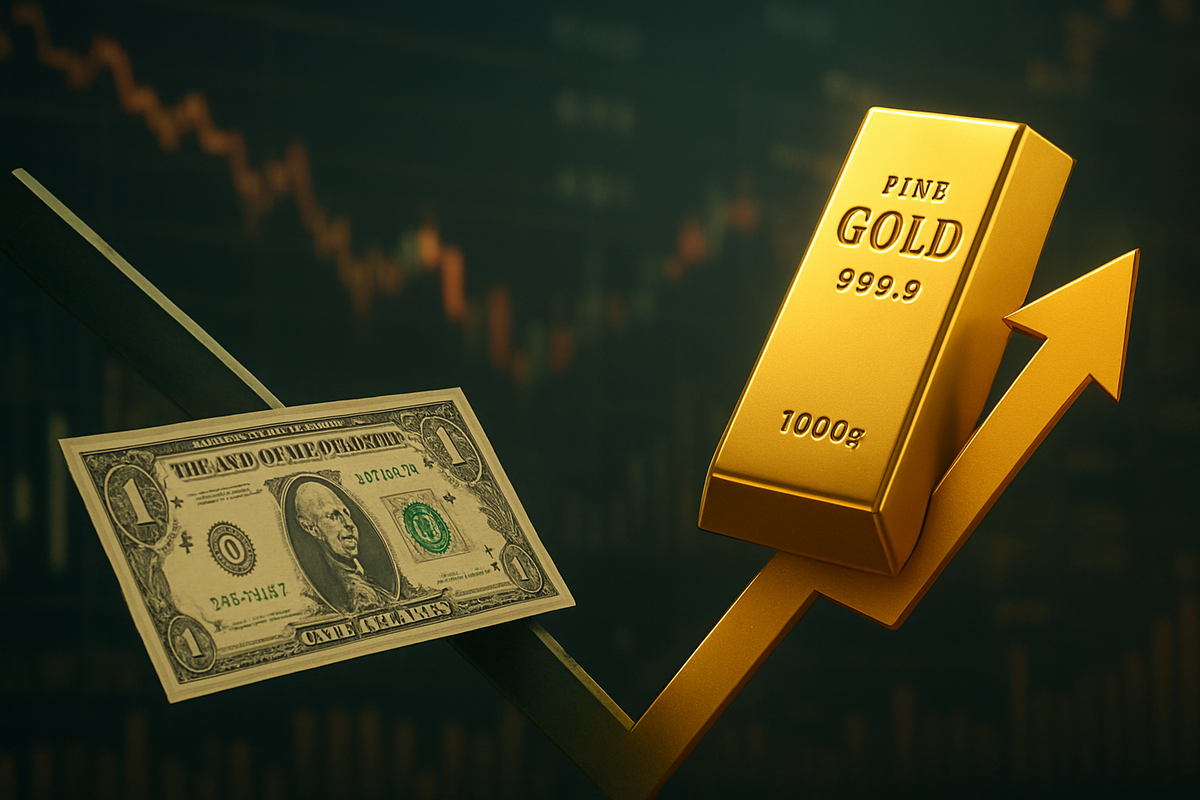
The financial markets are currently witnessing a compelling narrative unfold as the US dollar experiences a significant softening, directly correlating with a remarkable surge in gold prices. This inverse relationship, a long-standing tenet of commodity economics, has propelled the precious metal above critical psychological thresholds, with spot gold trading around an unprecedented $4,096 per ounce as of November 11, 2025, after briefly touching an all-time peak of $4,374 in October. This rally underscores gold's enduring appeal as a safe-haven asset amidst global economic uncertainties and shifting monetary policies.
The immediate implications of this trend are profound, signaling a potential recalibration in investor strategies and global reserve diversification. As central banks, particularly in Asia, continue to accumulate gold and investors seek hedges against inflation and currency devaluation, the bullish outlook for the precious metal remains strong. This dynamic environment suggests a sustained period of elevated gold prices, challenging traditional asset allocation models and hinting at broader shifts in the international financial landscape.
Detailed Coverage of the Event: A Dollar in Retreat, Gold on the Ascent
The journey of the US dollar into a period of significant weakness, particularly from late 2024 through November 2025, has been multifaceted. The US Dollar Index (DXY) has seen a substantial decline, dropping over 10% in the first half of 2025 and an additional 4-5% year-to-date by November. This depreciation, marking its worst performance in over half a century for such a period, is largely attributed to increasing expectations of US Federal Reserve interest rate cuts. With markets pricing in a high probability of further rate reductions by December 2025, the allure of dollar-denominated assets has diminished.
Compounding the dollar's woes are forecasts of slowing US economic growth, with projections falling from 2.8% in 2024 to 1.5% in 2025 and a mere 1% in 2026. Concerns over escalating US fiscal deficits and ongoing policy uncertainties, including debates around government shutdowns and trade policies, have further eroded investor confidence. This backdrop has prompted a significant global capital reallocation, with investors diversifying away from US dollar assets into other currencies, emerging market bonds, and most notably, gold. Key players in this diversification include central banks, with China actively increasing its gold holdings and reducing its reliance on the greenback.
In lockstep with the dollar's retreat, gold prices have embarked on an impressive rally. The precious metal breached $2,900 per ounce in February 2025, surged past $3,500 in April, and, for the first time in history, climbed above $4,000 per ounce in October 2025. This ascent is fueled not only by the dollar's weakness, which makes gold cheaper for international buyers, but also by robust safe-haven demand driven by geopolitical tensions, trade wars, and persistent inflation concerns. Central banks globally have emerged as significant buyers, with the World Gold Council reporting that 95% of central bankers anticipate increasing their gold holdings in 2025, underscoring a strategic shift towards greater financial stability and diversification away from the US dollar.
Corporate Fortunes Shift: Winners and Losers in a Weak Dollar, High Gold Environment
The current macroeconomic climate, characterized by a softening US dollar and soaring gold prices, is creating distinct winners and losers across various industries. Companies with direct exposure to gold production or significant international revenues are poised to benefit, while those reliant on gold as an input or heavily exposed to US dollar-denominated costs face considerable headwinds.
Gold mining companies stand out as primary beneficiaries. The surge in gold prices directly translates to higher revenues and expanded profit margins for producers. Companies like Newmont Corporation (NYSE: NEM), the world's largest gold producer, have seen their shares advance significantly, reflecting the positive impact of robust gold prices on their bottom line. Similarly, Barrick Gold (NYSE: GOLD), another major player, is expected to reap substantial rewards from this sustained upward trend in the precious metal's value.
Conversely, luxury jewelry retailers and manufacturers are experiencing considerable pressure. For conglomerates such as LVMH (EPA: MC), which owns iconic brands like Tiffany & Co. and Bulgari, the record-high gold prices translate directly into increased input costs. This squeezes gross margins and forces difficult decisions regarding pricing strategies, potentially impacting demand for high-end items. Other luxury groups like Richemont (SWX: CFR) (Cartier, Van Cleef & Arpels) and Kering (EPA: KER) (Boucheron) face similar challenges in maintaining profitability amidst escalating raw material expenses.
Beyond the direct gold market, US multinational corporations with substantial foreign sales are finding a weaker dollar to be a significant tailwind. When international earnings are converted back into US dollars, they are worth more, boosting reported profits. Giants like McDonald's Corporation (NYSE: MCD), Procter & Gamble Company (NYSE: PG), and Philip Morris International (NYSE: PM), with their vast global footprints, stand to see mechanical improvements in their dollar-denominated financial results. Technology firms such as Apple (NASDAQ: AAPL), Microsoft (NASDAQ: MSFT), Netflix (NASDAQ: NFLX), Meta Platforms (NASDAQ: META), and Electronic Arts (NASDAQ: EA) also benefit from this currency translation effect on their extensive international revenues. On the other hand, foreign companies with significant US revenue or operations find themselves at a disadvantage. Dutch health-technology company Royal Philips N.V. (AMS: PHIA, NYSE: PHG) and lighting manufacturer Signify N.V. (AMS: LIGHT) have already reported negative impacts from the weakening dollar on their US-derived earnings when converted back to their stronger home currencies.
Finally, US companies heavily reliant on gold as an input for technology or industrial applications, such as certain semiconductor manufacturers (e.g., Applied Materials (NASDAQ: AMAT)), face increased raw material costs. If these companies also import gold or other components, the weaker dollar further amplifies their expenses, creating a dual challenge to their profit margins and potentially necessitating strategic shifts towards cost-efficiency or alternative materials.
Wider Significance: Reshaping Global Finance and Trade
The intertwined dynamics of a weakening US dollar and surging gold prices in late 2025 are not merely market fluctuations; they represent fundamental shifts with far-reaching implications for global finance, trade, and geopolitical stability. This environment signals a profound re-evaluation of traditional asset valuations and monetary policies, echoing historical patterns where gold emerges as a crucial hedge against uncertainty.
Across commodity markets, the dollar's depreciation makes goods priced in the greenback—from oil and natural gas to agricultural products and other metals—more affordable for international buyers. This typically stimulates global demand and supports higher commodity prices, providing a broad tailwind for producers beyond just gold miners. Conversely, import-dependent industries within the US face increasing costs, which could lead to squeezed margins or necessitate price increases for consumers. This creates a complex trade-off, where US export-oriented industries gain a competitive edge due to cheaper American goods abroad, potentially boosting sales and foreign revenue conversions for multinational corporations.
A significant ripple effect is observed in Emerging Markets (EMs), where a weaker dollar alleviates the burden of servicing dollar-denominated debt, a common challenge for many developing economies. This can free up capital, stimulate investment, and foster economic growth. More broadly, the trend accelerates the ongoing de-dollarization efforts by central banks worldwide. Many central banks are actively diversifying their foreign exchange reserves by accumulating gold, reducing their reliance on the US dollar. Gold holdings now constitute almost 20% of official global reserves, a substantial increase from approximately 15% at the end of 2023, providing a structural floor for gold prices and indicating a strategic pivot towards greater financial independence. This shift, combined with increased demand for tangible assets, could also contribute to inflationary pressures globally, as the purchasing power of fiat currencies is increasingly questioned.
From a regulatory and policy standpoint, central banks, particularly the Federal Reserve, are at a critical juncture. The expectation of continued interest rate cuts in late 2025 is a primary driver of dollar weakness and enhances gold's attractiveness by reducing the opportunity cost of holding a non-yielding asset. However, persistent inflation could force the Fed to adopt a more cautious stance, potentially limiting the dollar's depreciation. Furthermore, concerns over escalating US national debt and political risks, exemplified by the ongoing US government shutdown in November 2025, contribute to a lack of confidence in dollar-denominated assets, reinforcing gold's safe-haven appeal. Policymakers face increasing pressure to address these fiscal imbalances to restore long-term stability.
Historically, the inverse relationship between the dollar and gold is well-documented. Periods of dollar strength, such as the early 1980s, saw gold prices decline, while episodes of dollar weakness and economic turmoil, like the 2008 Financial Crisis, propelled gold to record highs. More recently, gold's ascent from 2020 to 2024, surpassing $4,000 per ounce in October 2025, has been driven by a combination of geopolitical risks, trade tensions, and expectations of monetary easing. Past US government shutdowns have also consistently resulted in dollar weakness and provided support for gold prices, serving as a clear historical precedent for the current market dynamics.
What Comes Next: Navigating a Shifting Financial Landscape
The trajectory of a weakening US dollar and surging gold prices is poised to continue, driven by a complex interplay of monetary policy, fiscal pressures, and geopolitical factors. While short-term fluctuations are inevitable, the consensus among financial experts points towards a prolonged period of structural change, necessitating strategic adaptations from investors and businesses alike.
In the short-term (next 6-12 months), the US dollar is expected to remain range-bound, with continued softness likely in early 2026, though a potential rebound in Q2 2026 cannot be ruled out if inflation data shifts. Gold, after its rapid ascent, may experience some consolidation and volatility but is fundamentally supported to extend its rally into early 2026. Analysts from ING, JPMorgan, and Goldman Sachs project gold prices to hover around $4,000-$4,100 in early 2026, with UBS even forecasting an upside scenario of $4,700 if geopolitical risks intensify. The Federal Reserve's ongoing rate cuts throughout 2026 will be a critical determinant, keeping the dollar soft and enhancing gold's appeal.
Looking at the long-term (1-5 years and beyond), the outlook suggests a sustained bull market for gold and persistent structural weakness for the US dollar. Morgan Stanley estimates the dollar could depreciate by another 10% by the end of 2026, signaling the end of a 15-year bull cycle, driven by factors like increasing US fiscal debt and accelerated de-dollarization. Major financial institutions like J.P. Morgan Private Bank, Goldman Sachs Group, Bank of America, and Wells Fargo are converging on exceptionally bullish gold forecasts, projecting prices to top $5,000 per ounce by 2026. This sustained rally is underpinned by the ongoing, structural accumulation of gold by central banks, particularly in emerging markets, as a strategic shift in reserve management. This trend, coupled with the long-term drive towards a more multipolar monetary system, will further cement gold's role as a primary strategic reserve asset, immune to external sanctions and financial disruptions.
These dynamics necessitate significant strategic pivots. For investors, increasing allocation to gold (a mid-single-digit portfolio allocation is suggested by UBS) as a hedge against currency devaluation, inflation, and geopolitical risk is prudent. Buying gold on dips rather than chasing rallies is advised, and exploring gold mining stocks could offer additional opportunities. Diversification into international equities and broader commodities may also prove beneficial as a weaker dollar boosts US exporters and makes commodities more attractive for non-US buyers. Businesses with international operations, especially importers, will need robust hedging strategies against currency volatility, while exporters can leverage the weaker dollar for increased competitiveness. All companies should prioritize supply chain resilience amidst geopolitical uncertainties.
The market presents both opportunities and challenges. The clear opportunities lie in continued upside for gold, silver, and other precious metals, as well as broader commodities. US export-oriented businesses and emerging markets stand to gain. However, challenges include potential inflationary pressures from a weaker dollar, ongoing market volatility, and the risk of demand destruction for gold if prices become excessively high, particularly in the jewelry market. The underlying economic slowdown contributing to dollar weakness and safe-haven demand for gold could also pose broader challenges for businesses sensitive to consumer spending.
Comprehensive Wrap-Up: Gold's Enduring Appeal in a Changing World
The current financial landscape, marked by a weakening US dollar and a surging gold market, represents a pivotal moment with lasting implications. The direct inverse correlation between the dollar's value and gold prices has been dramatically illustrated, propelling gold past the critical $4,000 per ounce mark and solidifying its role as a premier safe-haven asset. This phenomenon is driven by a confluence of factors: the Federal Reserve's dovish pivot, slowing US economic growth, escalating fiscal deficits, and heightened geopolitical uncertainties.
Moving forward, the market is likely to remain dynamic, with a continued bias towards a softer dollar and elevated gold prices. The structural shift in central bank reserve management, characterized by persistent gold accumulation, provides a robust long-term floor for the precious metal. While short-term volatility is anticipated, the overarching trend suggests gold is on a path towards and potentially beyond $5,000 per ounce in the coming years, as predicted by major financial institutions. This underscores a broader re-evaluation of global financial architecture and a growing desire for assets independent of any single currency's fluctuations.
Investors should closely monitor the Federal Reserve's monetary policy decisions, particularly the pace and extent of interest rate cuts, as these will directly influence dollar strength and gold's opportunity cost. Further geopolitical developments and the evolution of global trade dynamics will also be crucial indicators. For businesses, adapting to currency volatility through hedging and optimizing supply chains for resilience will be paramount. Ultimately, the current environment highlights gold's enduring appeal as a store of value and a hedge against instability, positioning it as a cornerstone asset in an increasingly multipolar and uncertain global economy.
This content is intended for informational purposes only and is not financial advice





